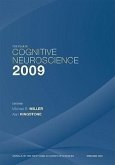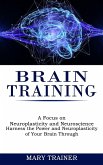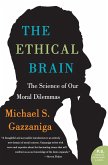The Neuroscience of Normal and Pathological Development
Herausgeber: Martin, Colin R; Rajendram, Rajkumar; Preedy, Victor R
The Neuroscience of Normal and Pathological Development
Herausgeber: Martin, Colin R; Rajendram, Rajkumar; Preedy, Victor R
- Broschiertes Buch
- Merkliste
- Auf die Merkliste
- Bewerten Bewerten
- Teilen
- Produkt teilen
- Produkterinnerung
- Produkterinnerung
Diagnosis, Management and Modeling of Neurodevelopmental Disorders: The Neuroscience of Development is a comprehensive reference on the diagnosis and management of neurodevelopment and associated disorders. This book discusses the mechanisms underlying neurological development and provides readers with a detailed introduction to the neural connections and complexities in biological circuitries, as well as the interactions between genetics, epigenetics and other micro-environmental processes. It also examines pharmacological and non-pharmacological interventions of development-related…mehr
Andere Kunden interessierten sich auch für
![The Neuroscience of Depression The Neuroscience of Depression]() The Neuroscience of Depression136,99 €
The Neuroscience of Depression136,99 €![Handbooks of Cognitive Behavioral Therapy Handbooks of Cognitive Behavioral Therapy]() Handbooks of Cognitive Behavioral Therapy355,99 €
Handbooks of Cognitive Behavioral Therapy355,99 €![The Year in Cognitive Neuroscience 2009, Volume 1156 The Year in Cognitive Neuroscience 2009, Volume 1156]() The Year in Cognitive Neuroscience 2009, Volume 1156159,99 €
The Year in Cognitive Neuroscience 2009, Volume 1156159,99 €![Brain Training Brain Training]() Mary TrainerBrain Training15,99 €
Mary TrainerBrain Training15,99 €![The Ethical Brain The Ethical Brain]() Michael S GazzanigaThe Ethical Brain17,99 €
Michael S GazzanigaThe Ethical Brain17,99 €![Foreign Accent Syndromes Foreign Accent Syndromes]() Jack RyallsForeign Accent Syndromes72,99 €
Jack RyallsForeign Accent Syndromes72,99 €![The Brain's Way of Healing The Brain's Way of Healing]() Norman DoidgeThe Brain's Way of Healing15,99 €
Norman DoidgeThe Brain's Way of Healing15,99 €-
-
-
Diagnosis, Management and Modeling of Neurodevelopmental Disorders: The Neuroscience of Development is a comprehensive reference on the diagnosis and management of neurodevelopment and associated disorders. This book discusses the mechanisms underlying neurological development and provides readers with a detailed introduction to the neural connections and complexities in biological circuitries, as well as the interactions between genetics, epigenetics and other micro-environmental processes. It also examines pharmacological and non-pharmacological interventions of development-related conditions. Factors Affecting Neurodevelopment: Genetics, Neurology, Behavior, and Diet is a comprehensive reference on the genetic and behavioral features associated with proper and abnormal development. This book discusses the mechanisms underlying neurological development and provides readers with a detailed introduction to the neural connections and complexities in biological circuitries, as well as the physiological, behavioral, molecular, and cellular features of neurodevelopment. It also examines in vitro and in vivo modelling of development with stem cells and model systems.
Produktdetails
- Produktdetails
- Verlag: Elsevier Science
- Seitenzahl: 1340
- Erscheinungstermin: 25. Juni 2021
- Englisch
- Gewicht: 3850g
- ISBN-13: 9780128183717
- ISBN-10: 0128183713
- Artikelnr.: 68278892
- Herstellerkennzeichnung
- Libri GmbH
- Europaallee 1
- 36244 Bad Hersfeld
- gpsr@libri.de
- Verlag: Elsevier Science
- Seitenzahl: 1340
- Erscheinungstermin: 25. Juni 2021
- Englisch
- Gewicht: 3850g
- ISBN-13: 9780128183717
- ISBN-10: 0128183713
- Artikelnr.: 68278892
- Herstellerkennzeichnung
- Libri GmbH
- Europaallee 1
- 36244 Bad Hersfeld
- gpsr@libri.de
Diagnosis, Management and Modeling of Neurodevelopmental Disorders: The
Neuroscience Of Development:
I. Introductory Chapters: Setting The Scene For The Neuroscience Of
Development
1. The brain and its structures: an overview; 2. Neural tube defects:
embryonic origin, clinical features and cell survival equilibrium impact;
3. Chemical substances affecting neurodevelopment; 4. High-risk babies and
Neurodevelopmental outcome; 5. Genomic Imprinting and neurodevelopment; 6.
Insights from model systems: Alcohol, neurodevelopment and zebrafish; 7.
Early life nutrition and brain development: maternal iodine nutrition and
neurodevelopment; 8. Endocrine Aspects of Development. Thyroid hormone
actions in neurological processes during brain development
II. Impairments and Diseases
9. Pediatric brain tumors; 10. Neurofibromatosis Type 1: from cellular
phenotypes to human brain function; 11. The role and development of neural
crest cells; 12. Spina Bifida: A Biopsychosocial Perspective; 13. Diabetic
ketoacidosis and neurodevelopment; 14. Four-dimensional features of fetal
brain: applications to diabetes; 15. Prenatally exposed to nicotine and
neurodevelopment; 16. Maternal methamphetamine and impact on the brain; 17.
Alcohol, cannabis and brain development; 18. The Environmental Pollutant
Trichloroethylene Disrupts Key Neural Pathways During Brain Development;
19. Developmental neurotoxicity of the herbicide atrazine; 20.
Neurodevelopmental delays and in utero hyperemesis gravidarum; 21.
Neurodevelopment and Infantile Epileptic Encephalopathy-9 (EIEE9); 22.
Neurodevelopment in Turner syndrome; 23. Very preterm children and the
impact on neurodevelopmental outcomes; 24. Linking congenital heart disease
and brain functional connectivity in newborns; 25. Brain Growth in
Congenital Heart Disease from Prenatal Environment to Adulthood; 26.
Linking dopamine, amphetamine and neurodevelopment; 27. Developmental
coordination disorder
III. Biomarkers, Screening, Methods and Diagnosis
28. Neurodevelopment and the The Ages and Stages Questionnaire, third
edition (ASQ-3); 29. Screening for Attention Deficit Hyperactivity Disorder
in children; 30. The Mini-Mental State Pediatric Examination screening
tool: Italian perspectives; 31. Predictors of neurodevelopment in preterm
infants: from the neonatal intensive care unit into adulthood; 32. The
antenatal fetal neurodevelopmental test: uses and applications
IV: Management and Treatments
33. Pain, evaluation and management in neurodevelopmental conditions; 34.
Use of levetiracetam: Features and applications to neonatal seizures; 35.
Quetiapine treatment in paediatric scenarios; 36. Treatments with
cannabinoids and brain development; 37. Pediatric dystonia and deep brain
stimulation; 38. Use of repetitive transcranial magnetic stimulation in
neurodevelopment: a narrative review; 39. Cognitive behavioral therapy in
children with anxiety disorders; 40. Cognitive behavioral therapy for
anxiety in children with autism spectrum disorder; 41. Nutritional
treatment in fetal alcohol spectrum disorder; 42. Nurturing the Developing
Brain to Reduce Neurological Delay; 43. Normalizing perinatal neurological
development via intervention
V. Models And Modelling
44. Microplatforms as a Model for Neurological Conditions; 45. Disease
models in neurodevelopmental disorders; 46. Endosulfan and impact on
neurodevelopment: modelling with zebrafish (Danio rerio); 47.
Neurodevelopment of the zebrafish spinal serotonin system; 48. Inbred mouse
model of brain development and intestinal microbiota; 49. The myelin mutant
taiep rat as a model of developmental disorder; 50. The MAM-E17
neurodevelopmental model of schizophrenia
VI. Resources
51. Research and recommended resources in the neuroscience of development
¿
Factors Affecting Neurodevelopment: Genetics, Neurology, Behavior, and
Diet:
I. Genetics, Molecular and Celluar Biology
1. Hereditary motor neuropathies; 2. Dopamine transporter (DAT1)
polymorphism and development; 3. Genome wide association studies (GWAS) and
neurodevelopment: Autism spectrum disorder; 4. SNPs and cerebral palsy; 5.
Epigenetic regulation of cortical neurogenesis; 6. Functions and dynamics
of axonal mitochondria; 7. Linking apoptosis and caspases in fetal neural
tube defects; 8. Brain oxidative stress in Down syndrome; 9. Linking
Adhesion GPCRs to Glial Cell Development and Function; 10. Immunoglobulin
cell adhesion molecule superfamily and neurodevelopment; 11. Brain-derived
neurotrophic factor (BDNF) and neurogenesis; 12. slc7a5 and neural
development; 13. Linking SOX3, SRY and disorders of neurodevelopment; 14.
Neuronal Src-homology-2 (SH2)B adaptor protein-1 (Sh2b1) and brain growth;
15. Effects of extrinsic factors and intracellular signalling and
transcription factors regulating the development and
cell fate of spinal cord ependymal cells; 16. Signaling molecules
controlling oligodendrocyte development and brain myelination
II. Neurological and Imaging Features
17. Fetal brain structures: imaging oriented; 18. Four-dimensional (4D)
ultrasonography: Methods, uses and fetal neuroscience; 19. Linking
histology and neurological development of the fetal and infant brain; 20.
Development of Corticospinal tract axons: from embryonic stage to
adulthood; 21. Vascular endothelial growth factor (VEGF) and
neurodevelopment; 22. Brain-wide connectivity architecture: developmental
aspects; 23. Development and pathology of the germinal matrix; 24.
Development of the GABAergic network in the mouse spinal cord; 25.
Postnatal development, electrophysiology and sensory sural nerves; 26.
Neuroscience of the developing axonal strata in the human fetal brain; 27.
Neuroactive steroids and neurodevelopment; 28. Voltage and ligand-gated ion
channels appearance and function in neurodevelopment; 29. Features of brain
development over 13 years in preterms; 30. The medial pulvinar in
neurodevelopment; 31. Cortical sulci in the human fetal brain and
development; 32. The prenatal development of the human cerebellum; 33.
Developing cerebello-cerebral connectivity in health and disease: a focus
on epilepsy; 34. Prenatal exposure to progestins: impact on
neurodevelopment of the child
III. Physiological Aspects
35. Brain lesion characteristics in relation to upper limb function in
children with unilateral cerebral palsy; 36. Maternal exercise and brain
development; 37. Pyramidal neurons: physiology, Pathophysiology and
postnatal development; 38. Working memory: physiology and neurodevelopment;
39. EEG development in resting states; 40. Availability and metabolism of
thyroid hormones in the developing brain
IV. Behavior And Psychopathological Aspects
41. Psychosocial issues and quality of life following childhood stroke; 42.
Neuropsychological function following childhood stroke; 43. Youths with
autism and working memory; 44. Linking the mesial temporal lobe, 3D
probabilistic maps and development; 45. Cognitive aspects of Down Syndrome;
46. Adolescent cannabis use and neurocognitive development; 47. The Role of
Social Anxiety in Autism and the Broader Autism Phenotype: Evidence from
Childhood through Adulthood; 48. Impact of touch on bonding and
neurodevelopment; 49. Neurobehaviour and catch up growth
V. Diet And Nutrition
50. Caloric restriction and the developing brain; 51. High-fat diet,
tryptophan hydroxylase-2 mRNA expression and neurodevelopment; 52. Bone
mineral density and nutritional status in children with cerebral palsy; 53.
Epigallocatechin-3-gallate: linking the neurogenesis, hippocampus and Down
syndrome; 54. Folic acid-to prevent spina bifida and anencephaly
Neuroscience Of Development:
I. Introductory Chapters: Setting The Scene For The Neuroscience Of
Development
1. The brain and its structures: an overview; 2. Neural tube defects:
embryonic origin, clinical features and cell survival equilibrium impact;
3. Chemical substances affecting neurodevelopment; 4. High-risk babies and
Neurodevelopmental outcome; 5. Genomic Imprinting and neurodevelopment; 6.
Insights from model systems: Alcohol, neurodevelopment and zebrafish; 7.
Early life nutrition and brain development: maternal iodine nutrition and
neurodevelopment; 8. Endocrine Aspects of Development. Thyroid hormone
actions in neurological processes during brain development
II. Impairments and Diseases
9. Pediatric brain tumors; 10. Neurofibromatosis Type 1: from cellular
phenotypes to human brain function; 11. The role and development of neural
crest cells; 12. Spina Bifida: A Biopsychosocial Perspective; 13. Diabetic
ketoacidosis and neurodevelopment; 14. Four-dimensional features of fetal
brain: applications to diabetes; 15. Prenatally exposed to nicotine and
neurodevelopment; 16. Maternal methamphetamine and impact on the brain; 17.
Alcohol, cannabis and brain development; 18. The Environmental Pollutant
Trichloroethylene Disrupts Key Neural Pathways During Brain Development;
19. Developmental neurotoxicity of the herbicide atrazine; 20.
Neurodevelopmental delays and in utero hyperemesis gravidarum; 21.
Neurodevelopment and Infantile Epileptic Encephalopathy-9 (EIEE9); 22.
Neurodevelopment in Turner syndrome; 23. Very preterm children and the
impact on neurodevelopmental outcomes; 24. Linking congenital heart disease
and brain functional connectivity in newborns; 25. Brain Growth in
Congenital Heart Disease from Prenatal Environment to Adulthood; 26.
Linking dopamine, amphetamine and neurodevelopment; 27. Developmental
coordination disorder
III. Biomarkers, Screening, Methods and Diagnosis
28. Neurodevelopment and the The Ages and Stages Questionnaire, third
edition (ASQ-3); 29. Screening for Attention Deficit Hyperactivity Disorder
in children; 30. The Mini-Mental State Pediatric Examination screening
tool: Italian perspectives; 31. Predictors of neurodevelopment in preterm
infants: from the neonatal intensive care unit into adulthood; 32. The
antenatal fetal neurodevelopmental test: uses and applications
IV: Management and Treatments
33. Pain, evaluation and management in neurodevelopmental conditions; 34.
Use of levetiracetam: Features and applications to neonatal seizures; 35.
Quetiapine treatment in paediatric scenarios; 36. Treatments with
cannabinoids and brain development; 37. Pediatric dystonia and deep brain
stimulation; 38. Use of repetitive transcranial magnetic stimulation in
neurodevelopment: a narrative review; 39. Cognitive behavioral therapy in
children with anxiety disorders; 40. Cognitive behavioral therapy for
anxiety in children with autism spectrum disorder; 41. Nutritional
treatment in fetal alcohol spectrum disorder; 42. Nurturing the Developing
Brain to Reduce Neurological Delay; 43. Normalizing perinatal neurological
development via intervention
V. Models And Modelling
44. Microplatforms as a Model for Neurological Conditions; 45. Disease
models in neurodevelopmental disorders; 46. Endosulfan and impact on
neurodevelopment: modelling with zebrafish (Danio rerio); 47.
Neurodevelopment of the zebrafish spinal serotonin system; 48. Inbred mouse
model of brain development and intestinal microbiota; 49. The myelin mutant
taiep rat as a model of developmental disorder; 50. The MAM-E17
neurodevelopmental model of schizophrenia
VI. Resources
51. Research and recommended resources in the neuroscience of development
¿
Factors Affecting Neurodevelopment: Genetics, Neurology, Behavior, and
Diet:
I. Genetics, Molecular and Celluar Biology
1. Hereditary motor neuropathies; 2. Dopamine transporter (DAT1)
polymorphism and development; 3. Genome wide association studies (GWAS) and
neurodevelopment: Autism spectrum disorder; 4. SNPs and cerebral palsy; 5.
Epigenetic regulation of cortical neurogenesis; 6. Functions and dynamics
of axonal mitochondria; 7. Linking apoptosis and caspases in fetal neural
tube defects; 8. Brain oxidative stress in Down syndrome; 9. Linking
Adhesion GPCRs to Glial Cell Development and Function; 10. Immunoglobulin
cell adhesion molecule superfamily and neurodevelopment; 11. Brain-derived
neurotrophic factor (BDNF) and neurogenesis; 12. slc7a5 and neural
development; 13. Linking SOX3, SRY and disorders of neurodevelopment; 14.
Neuronal Src-homology-2 (SH2)B adaptor protein-1 (Sh2b1) and brain growth;
15. Effects of extrinsic factors and intracellular signalling and
transcription factors regulating the development and
cell fate of spinal cord ependymal cells; 16. Signaling molecules
controlling oligodendrocyte development and brain myelination
II. Neurological and Imaging Features
17. Fetal brain structures: imaging oriented; 18. Four-dimensional (4D)
ultrasonography: Methods, uses and fetal neuroscience; 19. Linking
histology and neurological development of the fetal and infant brain; 20.
Development of Corticospinal tract axons: from embryonic stage to
adulthood; 21. Vascular endothelial growth factor (VEGF) and
neurodevelopment; 22. Brain-wide connectivity architecture: developmental
aspects; 23. Development and pathology of the germinal matrix; 24.
Development of the GABAergic network in the mouse spinal cord; 25.
Postnatal development, electrophysiology and sensory sural nerves; 26.
Neuroscience of the developing axonal strata in the human fetal brain; 27.
Neuroactive steroids and neurodevelopment; 28. Voltage and ligand-gated ion
channels appearance and function in neurodevelopment; 29. Features of brain
development over 13 years in preterms; 30. The medial pulvinar in
neurodevelopment; 31. Cortical sulci in the human fetal brain and
development; 32. The prenatal development of the human cerebellum; 33.
Developing cerebello-cerebral connectivity in health and disease: a focus
on epilepsy; 34. Prenatal exposure to progestins: impact on
neurodevelopment of the child
III. Physiological Aspects
35. Brain lesion characteristics in relation to upper limb function in
children with unilateral cerebral palsy; 36. Maternal exercise and brain
development; 37. Pyramidal neurons: physiology, Pathophysiology and
postnatal development; 38. Working memory: physiology and neurodevelopment;
39. EEG development in resting states; 40. Availability and metabolism of
thyroid hormones in the developing brain
IV. Behavior And Psychopathological Aspects
41. Psychosocial issues and quality of life following childhood stroke; 42.
Neuropsychological function following childhood stroke; 43. Youths with
autism and working memory; 44. Linking the mesial temporal lobe, 3D
probabilistic maps and development; 45. Cognitive aspects of Down Syndrome;
46. Adolescent cannabis use and neurocognitive development; 47. The Role of
Social Anxiety in Autism and the Broader Autism Phenotype: Evidence from
Childhood through Adulthood; 48. Impact of touch on bonding and
neurodevelopment; 49. Neurobehaviour and catch up growth
V. Diet And Nutrition
50. Caloric restriction and the developing brain; 51. High-fat diet,
tryptophan hydroxylase-2 mRNA expression and neurodevelopment; 52. Bone
mineral density and nutritional status in children with cerebral palsy; 53.
Epigallocatechin-3-gallate: linking the neurogenesis, hippocampus and Down
syndrome; 54. Folic acid-to prevent spina bifida and anencephaly
Diagnosis, Management and Modeling of Neurodevelopmental Disorders: The
Neuroscience Of Development:
I. Introductory Chapters: Setting The Scene For The Neuroscience Of
Development
1. The brain and its structures: an overview; 2. Neural tube defects:
embryonic origin, clinical features and cell survival equilibrium impact;
3. Chemical substances affecting neurodevelopment; 4. High-risk babies and
Neurodevelopmental outcome; 5. Genomic Imprinting and neurodevelopment; 6.
Insights from model systems: Alcohol, neurodevelopment and zebrafish; 7.
Early life nutrition and brain development: maternal iodine nutrition and
neurodevelopment; 8. Endocrine Aspects of Development. Thyroid hormone
actions in neurological processes during brain development
II. Impairments and Diseases
9. Pediatric brain tumors; 10. Neurofibromatosis Type 1: from cellular
phenotypes to human brain function; 11. The role and development of neural
crest cells; 12. Spina Bifida: A Biopsychosocial Perspective; 13. Diabetic
ketoacidosis and neurodevelopment; 14. Four-dimensional features of fetal
brain: applications to diabetes; 15. Prenatally exposed to nicotine and
neurodevelopment; 16. Maternal methamphetamine and impact on the brain; 17.
Alcohol, cannabis and brain development; 18. The Environmental Pollutant
Trichloroethylene Disrupts Key Neural Pathways During Brain Development;
19. Developmental neurotoxicity of the herbicide atrazine; 20.
Neurodevelopmental delays and in utero hyperemesis gravidarum; 21.
Neurodevelopment and Infantile Epileptic Encephalopathy-9 (EIEE9); 22.
Neurodevelopment in Turner syndrome; 23. Very preterm children and the
impact on neurodevelopmental outcomes; 24. Linking congenital heart disease
and brain functional connectivity in newborns; 25. Brain Growth in
Congenital Heart Disease from Prenatal Environment to Adulthood; 26.
Linking dopamine, amphetamine and neurodevelopment; 27. Developmental
coordination disorder
III. Biomarkers, Screening, Methods and Diagnosis
28. Neurodevelopment and the The Ages and Stages Questionnaire, third
edition (ASQ-3); 29. Screening for Attention Deficit Hyperactivity Disorder
in children; 30. The Mini-Mental State Pediatric Examination screening
tool: Italian perspectives; 31. Predictors of neurodevelopment in preterm
infants: from the neonatal intensive care unit into adulthood; 32. The
antenatal fetal neurodevelopmental test: uses and applications
IV: Management and Treatments
33. Pain, evaluation and management in neurodevelopmental conditions; 34.
Use of levetiracetam: Features and applications to neonatal seizures; 35.
Quetiapine treatment in paediatric scenarios; 36. Treatments with
cannabinoids and brain development; 37. Pediatric dystonia and deep brain
stimulation; 38. Use of repetitive transcranial magnetic stimulation in
neurodevelopment: a narrative review; 39. Cognitive behavioral therapy in
children with anxiety disorders; 40. Cognitive behavioral therapy for
anxiety in children with autism spectrum disorder; 41. Nutritional
treatment in fetal alcohol spectrum disorder; 42. Nurturing the Developing
Brain to Reduce Neurological Delay; 43. Normalizing perinatal neurological
development via intervention
V. Models And Modelling
44. Microplatforms as a Model for Neurological Conditions; 45. Disease
models in neurodevelopmental disorders; 46. Endosulfan and impact on
neurodevelopment: modelling with zebrafish (Danio rerio); 47.
Neurodevelopment of the zebrafish spinal serotonin system; 48. Inbred mouse
model of brain development and intestinal microbiota; 49. The myelin mutant
taiep rat as a model of developmental disorder; 50. The MAM-E17
neurodevelopmental model of schizophrenia
VI. Resources
51. Research and recommended resources in the neuroscience of development
¿
Factors Affecting Neurodevelopment: Genetics, Neurology, Behavior, and
Diet:
I. Genetics, Molecular and Celluar Biology
1. Hereditary motor neuropathies; 2. Dopamine transporter (DAT1)
polymorphism and development; 3. Genome wide association studies (GWAS) and
neurodevelopment: Autism spectrum disorder; 4. SNPs and cerebral palsy; 5.
Epigenetic regulation of cortical neurogenesis; 6. Functions and dynamics
of axonal mitochondria; 7. Linking apoptosis and caspases in fetal neural
tube defects; 8. Brain oxidative stress in Down syndrome; 9. Linking
Adhesion GPCRs to Glial Cell Development and Function; 10. Immunoglobulin
cell adhesion molecule superfamily and neurodevelopment; 11. Brain-derived
neurotrophic factor (BDNF) and neurogenesis; 12. slc7a5 and neural
development; 13. Linking SOX3, SRY and disorders of neurodevelopment; 14.
Neuronal Src-homology-2 (SH2)B adaptor protein-1 (Sh2b1) and brain growth;
15. Effects of extrinsic factors and intracellular signalling and
transcription factors regulating the development and
cell fate of spinal cord ependymal cells; 16. Signaling molecules
controlling oligodendrocyte development and brain myelination
II. Neurological and Imaging Features
17. Fetal brain structures: imaging oriented; 18. Four-dimensional (4D)
ultrasonography: Methods, uses and fetal neuroscience; 19. Linking
histology and neurological development of the fetal and infant brain; 20.
Development of Corticospinal tract axons: from embryonic stage to
adulthood; 21. Vascular endothelial growth factor (VEGF) and
neurodevelopment; 22. Brain-wide connectivity architecture: developmental
aspects; 23. Development and pathology of the germinal matrix; 24.
Development of the GABAergic network in the mouse spinal cord; 25.
Postnatal development, electrophysiology and sensory sural nerves; 26.
Neuroscience of the developing axonal strata in the human fetal brain; 27.
Neuroactive steroids and neurodevelopment; 28. Voltage and ligand-gated ion
channels appearance and function in neurodevelopment; 29. Features of brain
development over 13 years in preterms; 30. The medial pulvinar in
neurodevelopment; 31. Cortical sulci in the human fetal brain and
development; 32. The prenatal development of the human cerebellum; 33.
Developing cerebello-cerebral connectivity in health and disease: a focus
on epilepsy; 34. Prenatal exposure to progestins: impact on
neurodevelopment of the child
III. Physiological Aspects
35. Brain lesion characteristics in relation to upper limb function in
children with unilateral cerebral palsy; 36. Maternal exercise and brain
development; 37. Pyramidal neurons: physiology, Pathophysiology and
postnatal development; 38. Working memory: physiology and neurodevelopment;
39. EEG development in resting states; 40. Availability and metabolism of
thyroid hormones in the developing brain
IV. Behavior And Psychopathological Aspects
41. Psychosocial issues and quality of life following childhood stroke; 42.
Neuropsychological function following childhood stroke; 43. Youths with
autism and working memory; 44. Linking the mesial temporal lobe, 3D
probabilistic maps and development; 45. Cognitive aspects of Down Syndrome;
46. Adolescent cannabis use and neurocognitive development; 47. The Role of
Social Anxiety in Autism and the Broader Autism Phenotype: Evidence from
Childhood through Adulthood; 48. Impact of touch on bonding and
neurodevelopment; 49. Neurobehaviour and catch up growth
V. Diet And Nutrition
50. Caloric restriction and the developing brain; 51. High-fat diet,
tryptophan hydroxylase-2 mRNA expression and neurodevelopment; 52. Bone
mineral density and nutritional status in children with cerebral palsy; 53.
Epigallocatechin-3-gallate: linking the neurogenesis, hippocampus and Down
syndrome; 54. Folic acid-to prevent spina bifida and anencephaly
Neuroscience Of Development:
I. Introductory Chapters: Setting The Scene For The Neuroscience Of
Development
1. The brain and its structures: an overview; 2. Neural tube defects:
embryonic origin, clinical features and cell survival equilibrium impact;
3. Chemical substances affecting neurodevelopment; 4. High-risk babies and
Neurodevelopmental outcome; 5. Genomic Imprinting and neurodevelopment; 6.
Insights from model systems: Alcohol, neurodevelopment and zebrafish; 7.
Early life nutrition and brain development: maternal iodine nutrition and
neurodevelopment; 8. Endocrine Aspects of Development. Thyroid hormone
actions in neurological processes during brain development
II. Impairments and Diseases
9. Pediatric brain tumors; 10. Neurofibromatosis Type 1: from cellular
phenotypes to human brain function; 11. The role and development of neural
crest cells; 12. Spina Bifida: A Biopsychosocial Perspective; 13. Diabetic
ketoacidosis and neurodevelopment; 14. Four-dimensional features of fetal
brain: applications to diabetes; 15. Prenatally exposed to nicotine and
neurodevelopment; 16. Maternal methamphetamine and impact on the brain; 17.
Alcohol, cannabis and brain development; 18. The Environmental Pollutant
Trichloroethylene Disrupts Key Neural Pathways During Brain Development;
19. Developmental neurotoxicity of the herbicide atrazine; 20.
Neurodevelopmental delays and in utero hyperemesis gravidarum; 21.
Neurodevelopment and Infantile Epileptic Encephalopathy-9 (EIEE9); 22.
Neurodevelopment in Turner syndrome; 23. Very preterm children and the
impact on neurodevelopmental outcomes; 24. Linking congenital heart disease
and brain functional connectivity in newborns; 25. Brain Growth in
Congenital Heart Disease from Prenatal Environment to Adulthood; 26.
Linking dopamine, amphetamine and neurodevelopment; 27. Developmental
coordination disorder
III. Biomarkers, Screening, Methods and Diagnosis
28. Neurodevelopment and the The Ages and Stages Questionnaire, third
edition (ASQ-3); 29. Screening for Attention Deficit Hyperactivity Disorder
in children; 30. The Mini-Mental State Pediatric Examination screening
tool: Italian perspectives; 31. Predictors of neurodevelopment in preterm
infants: from the neonatal intensive care unit into adulthood; 32. The
antenatal fetal neurodevelopmental test: uses and applications
IV: Management and Treatments
33. Pain, evaluation and management in neurodevelopmental conditions; 34.
Use of levetiracetam: Features and applications to neonatal seizures; 35.
Quetiapine treatment in paediatric scenarios; 36. Treatments with
cannabinoids and brain development; 37. Pediatric dystonia and deep brain
stimulation; 38. Use of repetitive transcranial magnetic stimulation in
neurodevelopment: a narrative review; 39. Cognitive behavioral therapy in
children with anxiety disorders; 40. Cognitive behavioral therapy for
anxiety in children with autism spectrum disorder; 41. Nutritional
treatment in fetal alcohol spectrum disorder; 42. Nurturing the Developing
Brain to Reduce Neurological Delay; 43. Normalizing perinatal neurological
development via intervention
V. Models And Modelling
44. Microplatforms as a Model for Neurological Conditions; 45. Disease
models in neurodevelopmental disorders; 46. Endosulfan and impact on
neurodevelopment: modelling with zebrafish (Danio rerio); 47.
Neurodevelopment of the zebrafish spinal serotonin system; 48. Inbred mouse
model of brain development and intestinal microbiota; 49. The myelin mutant
taiep rat as a model of developmental disorder; 50. The MAM-E17
neurodevelopmental model of schizophrenia
VI. Resources
51. Research and recommended resources in the neuroscience of development
¿
Factors Affecting Neurodevelopment: Genetics, Neurology, Behavior, and
Diet:
I. Genetics, Molecular and Celluar Biology
1. Hereditary motor neuropathies; 2. Dopamine transporter (DAT1)
polymorphism and development; 3. Genome wide association studies (GWAS) and
neurodevelopment: Autism spectrum disorder; 4. SNPs and cerebral palsy; 5.
Epigenetic regulation of cortical neurogenesis; 6. Functions and dynamics
of axonal mitochondria; 7. Linking apoptosis and caspases in fetal neural
tube defects; 8. Brain oxidative stress in Down syndrome; 9. Linking
Adhesion GPCRs to Glial Cell Development and Function; 10. Immunoglobulin
cell adhesion molecule superfamily and neurodevelopment; 11. Brain-derived
neurotrophic factor (BDNF) and neurogenesis; 12. slc7a5 and neural
development; 13. Linking SOX3, SRY and disorders of neurodevelopment; 14.
Neuronal Src-homology-2 (SH2)B adaptor protein-1 (Sh2b1) and brain growth;
15. Effects of extrinsic factors and intracellular signalling and
transcription factors regulating the development and
cell fate of spinal cord ependymal cells; 16. Signaling molecules
controlling oligodendrocyte development and brain myelination
II. Neurological and Imaging Features
17. Fetal brain structures: imaging oriented; 18. Four-dimensional (4D)
ultrasonography: Methods, uses and fetal neuroscience; 19. Linking
histology and neurological development of the fetal and infant brain; 20.
Development of Corticospinal tract axons: from embryonic stage to
adulthood; 21. Vascular endothelial growth factor (VEGF) and
neurodevelopment; 22. Brain-wide connectivity architecture: developmental
aspects; 23. Development and pathology of the germinal matrix; 24.
Development of the GABAergic network in the mouse spinal cord; 25.
Postnatal development, electrophysiology and sensory sural nerves; 26.
Neuroscience of the developing axonal strata in the human fetal brain; 27.
Neuroactive steroids and neurodevelopment; 28. Voltage and ligand-gated ion
channels appearance and function in neurodevelopment; 29. Features of brain
development over 13 years in preterms; 30. The medial pulvinar in
neurodevelopment; 31. Cortical sulci in the human fetal brain and
development; 32. The prenatal development of the human cerebellum; 33.
Developing cerebello-cerebral connectivity in health and disease: a focus
on epilepsy; 34. Prenatal exposure to progestins: impact on
neurodevelopment of the child
III. Physiological Aspects
35. Brain lesion characteristics in relation to upper limb function in
children with unilateral cerebral palsy; 36. Maternal exercise and brain
development; 37. Pyramidal neurons: physiology, Pathophysiology and
postnatal development; 38. Working memory: physiology and neurodevelopment;
39. EEG development in resting states; 40. Availability and metabolism of
thyroid hormones in the developing brain
IV. Behavior And Psychopathological Aspects
41. Psychosocial issues and quality of life following childhood stroke; 42.
Neuropsychological function following childhood stroke; 43. Youths with
autism and working memory; 44. Linking the mesial temporal lobe, 3D
probabilistic maps and development; 45. Cognitive aspects of Down Syndrome;
46. Adolescent cannabis use and neurocognitive development; 47. The Role of
Social Anxiety in Autism and the Broader Autism Phenotype: Evidence from
Childhood through Adulthood; 48. Impact of touch on bonding and
neurodevelopment; 49. Neurobehaviour and catch up growth
V. Diet And Nutrition
50. Caloric restriction and the developing brain; 51. High-fat diet,
tryptophan hydroxylase-2 mRNA expression and neurodevelopment; 52. Bone
mineral density and nutritional status in children with cerebral palsy; 53.
Epigallocatechin-3-gallate: linking the neurogenesis, hippocampus and Down
syndrome; 54. Folic acid-to prevent spina bifida and anencephaly


